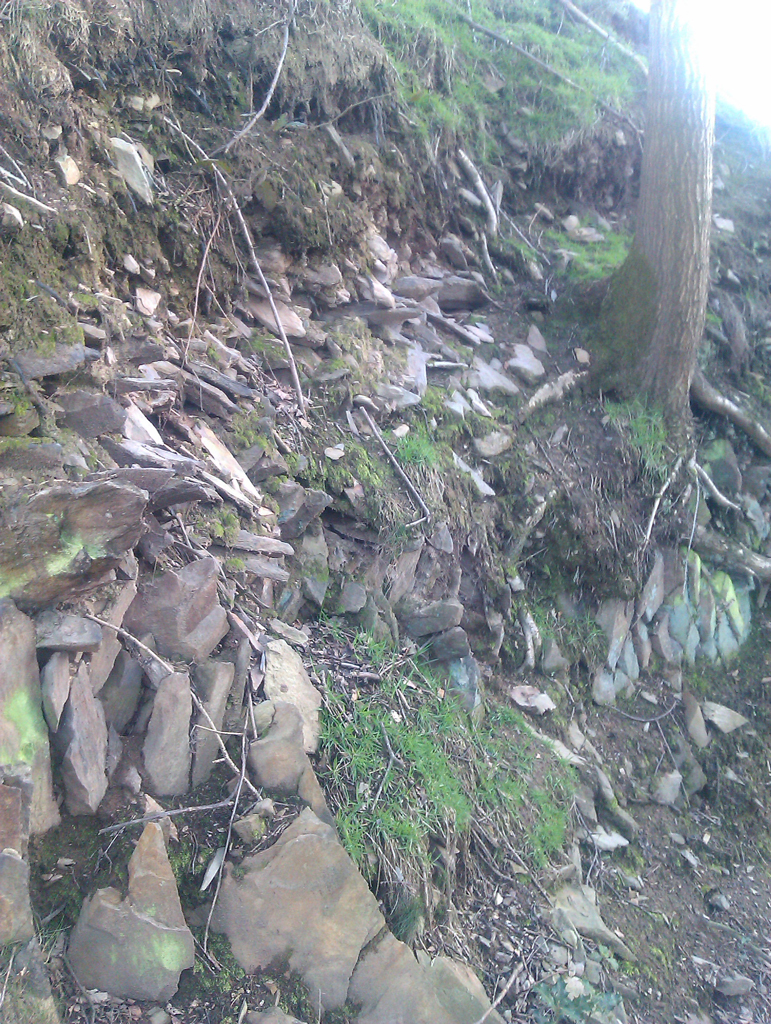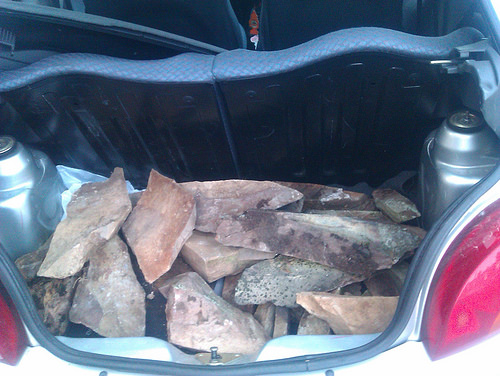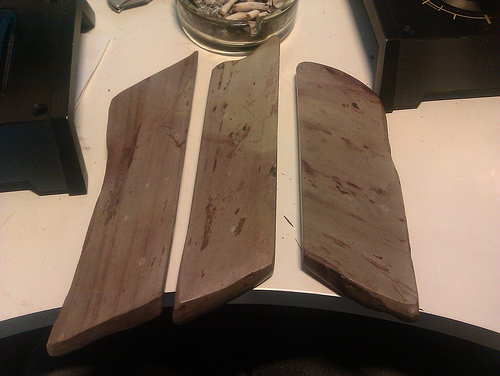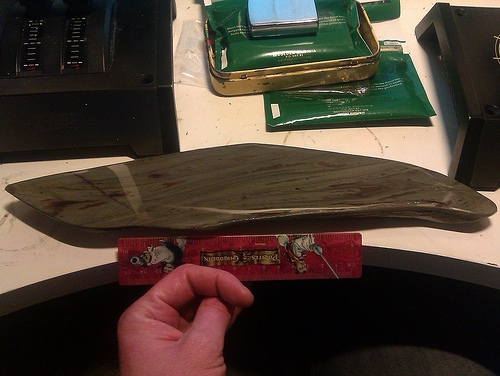Results 1 to 10 of 15
Thread: Charnley Forest adoption
-
03-19-2014, 07:14 PM #1Str8Faced Gent.






- Join Date
- Aug 2013
- Location
- Orangeville, Ontario
- Posts
- 8,456
- Blog Entries
- 1
Thanked: 4207 Charnley Forest adoption
Charnley Forest adoption
Received a vintage CF hone today from England.
Nice size for my style at 7" stone length.
Looking forward to testing her out.
cheers.
-
03-19-2014, 07:39 PM #2

Looks like a whittle hill quarry stone. Should be fairly soft to lap if my test bouts are anything to go by. And it should have pink/orange slurry due to the large inclusion.
Here's a picture of the actual whittle hill site.

Expect that stone to cut very fast. I'm still playing about with the stone I collected a few weeks ago and planning another visit to try get better samples. Lap it with a DTM. Then give it some abuse like you would with an Arkie. You should be able to get the surface to start to break into small shiney spots. If you have another hard stone that is flat rubbing the pair together will benefit the CF face, I've been breaking my samples on a green diorite bout, I would expect any smooth hard stone would have a similar effect.Last edited by Iceni; 03-19-2014 at 07:48 PM.
-
The Following User Says Thank You to Iceni For This Useful Post:
MikeB52 (03-19-2014)
-
03-19-2014, 10:23 PM #3Str8Faced Gent.






- Join Date
- Aug 2013
- Location
- Orangeville, Ontario
- Posts
- 8,456
- Blog Entries
- 1
Thanked: 4207
Thanks for the pic of the site Iceni. You go there on occasion do you? Gorgeous looking area. Totally unlike the open pit limestone quarry I spent some time in a few years back. Would like to see some shots of your finds, if only to drool on my ipad screen.
This one came without slurry stone, and I was thinking of using it with machine oil and as a finisher only but will probably start with water and may lap it. It comes out of its case but the bottom is curved and covered in some red craggy looking sealant/adhesive.
Anyway, thanks for showing me the birth site, as it were.
-
03-19-2014, 10:54 PM #4

My finds are nothing special yet. The first batch from the site is more a test than anything. I have a few test bouts that have been cut. None are great as I'm an infant in terms of stone cutting knowledge. The first cuts have been more of an experiment than anything.
That been said the stone is easy to farm. You literally pull the lumps out of the ground! I plan to go back armed with the knowledge from the first batch to be able to grade the lumps a little better, and perhaps produce something of worth.
I do have a lot of CF offcuts that would make ideal slurry stones. PM me your address and I'll post a few over.



I have another few cut as well, As I work through the lumps I'm getting a better feel for how the grain works. It's not like regular stone, the red and the green have different grain angles a lot of the time, and you get bars of harder inclusions as well as softer porous red inclusions to work round. I'd love to have a time machine and spend a day with one of the guys that used to work this stuff... But it's not been worked in a very long time.
-
03-20-2014, 01:08 AM #5Senior Member



- Join Date
- Apr 2008
- Location
- Essex, UK
- Posts
- 3,816
Thanked: 3164
In an article published in 1933 about the Cole Orton whetstone workers is a description of whetstone makers tools. They were surprisingly few: a heavy bladed long handled knife, a bench, sand and water.
The knife had the facility to be secured to the bench at the back, leaving the handle forward so it resembled a sheet steel bench cropper. This was the principle tool - it pared the stone down and was used to scrape the faces flat. One can only imagine the screeching din!
No doubt, like other rocks long lain in the ground, the stone was 'softer' when freshly raised out of the earth and having the so-called 'sap' still in it. I have worked stone like blue lias, etc, while in this 'green' state and can vouch that it is easier to work, leave it for a while and it dries harder.
The final facing was done in the traditional way with sharp sand worked into a slurry with water. The way in which this was implemented depended on the size of the outfit, but as most workers worked alone, with a few working as a family team, it was probably done by hand. When one considers that with o ly a rudimentary tool like the knife a skilled whetstone worker could have a stone ready in around 3 hours, smoothing by hand was probably like a walk in the park.
The boxes were either made indoors by different workers or by the users of the stones. As this type of stone was mainly used by carpenters and cabinet makers, the latter seems the more likely option.
Many think the stone was set in the box with plaster, but this is not so. The material may look superficially like plaster but in reality it was a mixture of whiting and boiled linseed oil, rather like a thin glaziers putty. This stuff sets hard, but those of us who used to be hell-bent on removing stones like this from their boxes know that heat, usually from the oven while the wife is not around, softens it, Plaster does not soften with heat.
The use of these hones for setting razors is more conjectural than factual. One of the only mentions of them being used with regard to razors and Sheffield comes from Holzapfel's masterly work on turning on the lathe in which he mentions that owing to their hardness they were suitable to strike the burr-edge of razors freshly ground on the wheel. I would imagine that other, faster, less adamantine hones were then used to set the edge.
Regards,
Neil
-
-
03-20-2014, 08:13 AM #6

Neil that's some great information!
-
03-20-2014, 03:58 PM #7
-
03-20-2014, 05:34 PM #8Str8Faced Gent.






- Join Date
- Aug 2013
- Location
- Orangeville, Ontario
- Posts
- 8,456
- Blog Entries
- 1
Thanked: 4207
Yea Mike thanks.
Colin, (I think that's his name) had one at your place last year during the meet and I was hooked after trying his. Figure I will be all set if we do a meet up this year between the CF, the cnat, and the ZG that's still en route. More finishers than technique here now, hehe.
But I'm learning..
-
03-20-2014, 09:47 PM #9Senior Member

- Join Date
- Mar 2009
- Posts
- 1,211
Thanked: 202
-
03-20-2014, 10:02 PM #10


 29Likes
29Likes LinkBack URL
LinkBack URL About LinkBacks
About LinkBacks






 Reply With Quote
Reply With Quote


